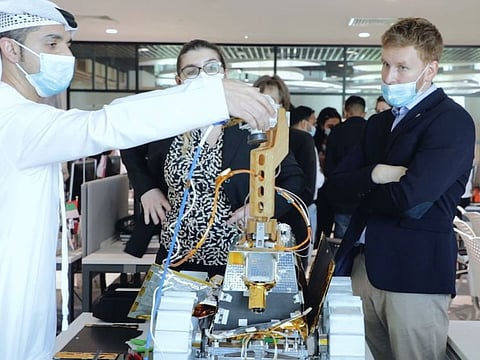Dubai partners with global entities for Moon mission’s science programme
Mohammed Bin Rashid Space Centre and partners to develop key instruments on Rashid rover

Dubai: The Mohammed Bin Rashid Space Centre (MBRSC) on Wednesday announced that it has partnered with local and international entities, institutions and agencies to develop the science programme for the Emirates Lunar Mission.
The partners will support the development of the main instruments on board the Rashid rover, including the Langmuir probe as well assist in data collection, landing site research, calibration strategies and data analysis.
Methodology
Based on the analysis of the scientific and engineering data requirements, MBRSC designed a science package consisting of a set of lightweight but powerful instruments that will be onboard the Rashid rover. These instruments will enable the rover to measure a carefully selected set of environmental conditions on the lunar surface. The demanding sensitivities of the instruments combined with the necessity of optimising between the rover and science instrument requirements resulted in the establishment of an international team of researchers, under the leadership of MBRSC.
Landing site research
MBRSC has partnered with the Centre for Petrographic and Geochemical Research at Universite de Lorraine in Nancy (France) to work on the characterisation of the conditions at the landing sites and analysis of the data from the rover’s microscopic imager. This microscopic imager, which was conceptualised by MBRSC, will obtain the highest resolution image from the lunar surface thus far and provide an unprecedented view of the undisturbed topmost layer of the lunar regolith. It is this upper layer which will show the imprint of the formation and evolution of the lunar surface at its smallest scales.
The team has also narrowed down the location where it intends to land, within a circle of 4km. The research into the landing site is essential, as the rover needs to avoid areas with high slopes or potential hazards. Available data of landing sites will also enable the team to find interesting targets that will help better understand the topography, geography and features of the rock and dust.
Langmuir probes
Furthermore, through its collaboration with the University of Oslo in Norway, the team is developing the Langmuir probes that will study the plasma around the Moon. The data will help the scientific community to understand how charged particles interact with the lunar surface. It is thought that this interaction can lift dust particles and carry them for certain distances.
UAE-based university collaboration
Meanwhile, closer to home, a team at New York University Abu Dhabi will work on the microscopic camera calibration, as well as on investigating the interaction of the rover’s surface materials with the solar radiation. The latter is of great importance to interpret the measurements of the plasma sheath.
“The partnership with local and international partners demonstrates the possibilities that the Emirates Lunar Mission’s science program offers academia. Students and early researchers are already participating in the development of this lunar rover project and are contributing to making qualitative developments in the fields of science, communication technologies and robotics. Furthermore, the impact of these developments will extend beyond the space sector and into various vital sectors in the UAE and around the world,” said Salem Humaid AlMarri, Director General, MBRSC.
MBRSC had recently announced its partnership with the French space agency, CNES to develop the two optical cameras (CASPEX) on board the Rashid rover. The Centre further stated that more partnerships will be announced in due course and will be added to the Emirates Lunar Mission’s science programme.
The Emirates Lunar Mission is one of the initiatives under the Mars 2117 Programme, which aims to build a human colony on Mars, and is funded by the ICT Fund under The Telecommunication and Digital Government Regulatory Authority (TDRA).
Sign up for the Daily Briefing
Get the latest news and updates straight to your inbox
